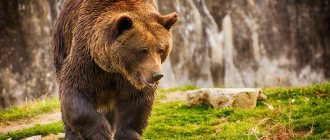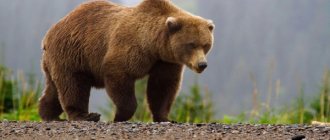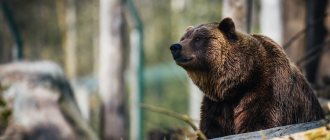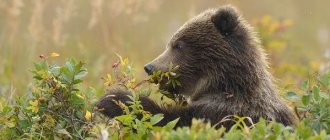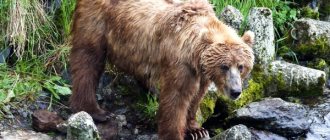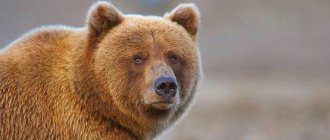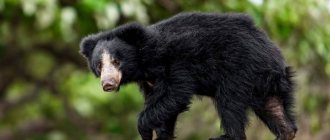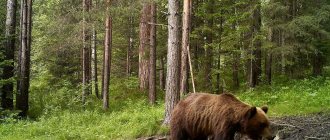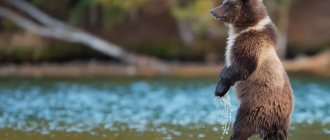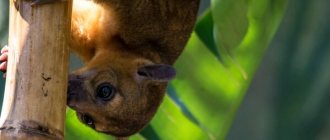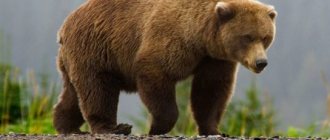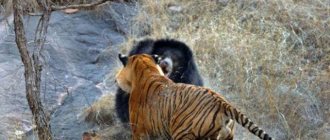If you ask a foreigner to say three association words about Russia, in most cases they will be bear, matryoshka and balalaika. Some will remember strong alcoholic drinks, earflap hats and extreme cold. But the brown bear is definitely a natural symbol of our country. The image of a bear adorns the coats of arms of many Russian cities: Yekaterinburg, Veliky Novgorod, Norilsk, Yaroslavl and others. The bear is called the "master of the forest", partly due to the fact that it is one of the largest land predators. The bear is a symbol of strength and power.
Description and dimensions
What does a brown bear look like? Many saw him in childhood, visiting the zoo or reading illustrated fairy tales, because the “clubfooted bear” is a frequent hero of children's literature. In nature, an adult brown bear is a large predatory animal with a large body. The bear's head is massive, but with small ears and eyes. Compared to polar bears, the brown representatives' heads are not very extended forward. The tail is short and does not stand out, because hidden under fur. The paws are large, powerful, with long claws up to 10 cm.
Brown bear
The fur is thick and long. The fur color of a brown bear ranges from light brown to black. Newborn cubs have light spots on their chest and neck that disappear over time. Brown bears molt once a year, but this process lasts from the beginning of spring to the end of autumn, until the animal goes into a den.
Brown bear family
The weight of different individuals of brown bears differs depending on the habitat of the animals. The largest predators live in Alaska and Kamchatka. Their weight on average is 500 kg, but there are individuals up to 750 kg. In Europe, the average weight of bears is 300-400 kg, and their length is from 1.2 to 2 meters. Grizzlies (North American brown bears), standing on their hind legs, will stretch out to 2.8-3 meters. Despite their massive size, bears run fast (at speeds of up to 50 km/h), swim well, and in their youth easily climb trees.
Brown bear behavior
Brown bears are forest animals.
In Russia, they prefer to live in continuous forests with dense thickets of deciduous trees, shrubs and grass; they enter the tundra and alpine forests. In Europe they live mainly in mountain forests, in North America - in the tundra, in alpine meadows and near the coasts. Males usually live alone, and females live together with cubs of different ages. The animals are territorial, their territories cover an area of 73-414 km², and in males they are always larger than in females. The bear marks the boundaries of the area with scent marks and “tear marks,” that is, by making scratches on trees. Can make seasonal migrations, which are associated with the search for food. Brown bears are active all day, but most of all in the morning and evening.
The life of these predators has a pronounced seasonal cycle. For the winter, the bears fatten up their subcutaneous fat (up to 180 kg), and in the fall they lie down in dens, which are located in dry places, in holes under windbreaks or under tree roots. Occasionally they dig shelters in the ground or look for caves and crevices in rocks. As a rule, bears come to permanent wintering sites from year to year. The duration of hibernation, depending on the region where the animal lives, is 75-195 days (from October-November to March-April, that is, about six months). Female bears with cubs stay in the shelters the longest; old males come out first. In the south of the range, in winters with little snow, hibernation is not typical for brown bears, but they also accumulate fat reserves due to a decrease in the amount of food. During the winter, the bear loses about 80 kg of fat.
Winter sleep of brown bears is shallow; their body temperature at this time is 29-34 degrees. If danger arises, the animal is able to quickly wake up and leave the den, and go in search of a new one. If the bear has not had time to fatten up properly in the fall, it may also wake up in the middle of winter and begin to wander around in search of food (in such cases it is called a connecting rod). The connecting rod is very dangerous, because due to hunger it becomes a merciless predator and even attacks people. Such a bear has little chance of waiting until spring.
Although the brown bear looks clumsy, it is capable of running fast and reaching speeds of up to 50 km/h, swims well and climbs trees, especially at a young age. One blow from a seasoned bear's paw breaks the backbone of a wild boar, deer or elk.
Varieties
The largest bear in the world: from grizzly to Kodiak and white
There are hundreds of varieties of brown bear. The most common are the common brown, grizzly and Kodiak (inhabit the islands of the Kodiak archipelago in Alaska). Subspecies are also known:
- Siberian brown bear (live in Siberia east of the Yenisei);
- Gobi brown bear - mazalay (lives in the Gobi Desert, Mongolia; listed in the Red Book because it is endangered);
- Tien Shan (lives in the Pamir, Tien Shan and Himalaya mountains);
- Ussuri, or Japanese;
- Tibetan;
- Syrian.
Habitat
The habitat of the brown bear in Russia occupies almost the entire forest and forest-tundra zone of the northern part of the country. In Europe, populations of brown predators are found in the Pyrenees, Cantabrian Mountains, Alps and Apennines. The animal also lives in Scandinavia and Finland. In Asia, this type of bear is common in Palestine, Iraq and Iran (in the north of the countries), China and Korea. In Japan, bears live on the island of Hokkaido. And residents of North America often encounter grizzly bears in Canada, Alaska and the northwestern United States.
Bear habitat
Regardless of the continent, brown bears preferably live in forests, tundra, taiga and mountains. Adult males often live alone, while females usually live with cubs. Adult bears like to mark their territory, which reaches up to 400 square meters. km.
Interesting facts about the brown bear:
- The skins of brown bears are used in making carpets, and the meat is eaten. The gallbladder is used in traditional Asian medicine. Healing properties are also attributed to bear fat.
- In some areas, brown bears damage crops, destroy apiaries and attack domestic animals. And although their commercial significance is small, hunting for this species in many regions is prohibited or limited. In addition, such hunting is very dangerous and requires weapons with high stopping power. Thus, hunting a brown bear with a Kalashnikov assault rifle can cause the death of the hunter, since the bear is able to kill him even after firing at point-blank range.
- Meeting brown bears in the wild can be deadly (especially with a female with cubs and cubs that have emerged from hibernation). But usually brown bears themselves avoid meeting people.
Nutrition
The brown bear is a predator, but its diet consists of 70-80% plant foods. He especially likes berries, nuts, acorns, stems and roots of forest plants. Bears love to feast on insects (ants and butterflies), worms, lizards, frogs and various rodents. Clubfoot's tastes include mice, marmots, gophers and chipmunks, but he prefers personally caught fish to all of them. It happens that a bear also eats the carcasses of ungulates: roe deer, fallow deer, elk and deer.
Brown bear eats fish
The plot of fairy tales, where a bear eats the contents of honey pots, is not fiction. In general, the etymology of the word “bear” is “knowing where the honey is”, “honey eater”.
Grizzlies living in Alaska also attack wolves, and Far Eastern brown bears hunt tigers. Bears often take prey from other predators. During the period of activity, the animal “eats” up to 200 kg of subcutaneous fat. With the resulting supply, the bear lies down to hibernate in a den.
Bears love honey
For dens, bears choose dry holes protected by windbreaks, sometimes they dig a hibernation “house” in the ground or occupy caves and rock crevices. The clubfoot's winter sleep usually lasts from 80 to 200 days. Females with their offspring spend the most time in dens, and older males spend the least amount of time. During hibernation, up to 80 kg of accumulated fat is spent.
Winter period
During the winter, bears hibernate in dens . They make dens on their own under fallen trees, drag moss into the dens and line a bed for themselves. Before entering winter hibernation, bears accumulate a large layer of fat, with which they receive nutrition for the body for the entire winter period. The amazing thing is that they can sleep for three to six months. During hibernation, a bear's pulse is eight beats per minute. It is also interesting that during the entire period that bears sleep, they do not defecate.
Reproduction
The mating season for brown bears begins in May-June. At this time, females go into estrus, which lasts 10-30 days. Males begin to actively select a mate for themselves, accompanying the search with strong roars and fights with other applicants, which sometimes end in death. During this period, males are very aggressive and dangerous. The established pair stays together for 30-40 days, and if a new one appears nearby who wants to be fertilized, then both the male and the female drive him away.
Brown bear cub
The female bear's embryo begins to develop with a delay, not earlier than November, and birth occurs in January or February. As a rule, 2-3 bear cubs are born, weighing 0.5-0.7 kg and up to 23 cm tall. Their fur is still short and sparse, their eyes do not see, and their ears do not hear. The cubs' hearing returns to normal only 2 weeks after birth, and their vision – after a month. By spring, babies have a full set of baby teeth and, in addition to mother's milk, they can already eat berries, plants and insects.
Mother bear and cubs
By the time they leave the den, the cubs weigh up to 7 kg. Throughout the first year of life, the offspring does not leave the mother. The family will also spend the next hibernation in the den together. By the age of three, the bears will become sexually mature and will finally separate from their parents. And the cubs will become adult males and females at 10-11 years of age.
By the way, the father does not participate in the life of the offspring; all the troubles fall on the bear. The total lifespan of brown bears is up to 30 years in the wild and up to 50 years in captivity.
Popular message topics
In 1981, humanity heard the word HIV infection for the first time. Two years later, this disease was already detected in many people. There is still no single strategy to overcome this scourge. The disease can only be detected and maintained
Nature has given people a lot of good things, but sometimes its phenomena are unpredictable and unpleasant. Among the natural phenomena that brings enormous inconvenience and damage to people, the tsunami stands out. Tsunamis are waves that are quite high.
The work of the great composer can be called innovative in the art of music. An example of this is the operas “Boris Godunov”, “Khovanshchina”, “Sorochinskaya Fair” and many other works. You can see a completely new style:
Source
